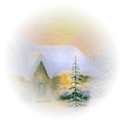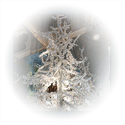The Christmas tree is still one of the Western world's most beloved symbols, although it had no meaning in the ancient world, but it was drawn almost entirely from pagan tree worship. Preserved through the centuries in central Europe, it was unknown in English speaking countries until 1840, when Prince Albert, the German bridegroom of Queen Victoria, brought the custom from his fatherland to England.
 The Christmas tree dated back to Yule celebrations (ancient Scandinavian Winter Solstice celebrations of renewal of life),
along with the candles, gifts,
and sacrificial pig with an apple in its mouth. But there were pagan elements from
southern Europe also. Certain priests of Attis called dendrophori "tree bearers" annually
selected the pine tree from the sacred grove (pinea silva) to carry the effigy of the
god into his Roman temple. The dendrophori were charged with the duty of setting up
and decorating the tree, upon which the god was presented for sacrifice. Perhaps
this was the origin of the custom of hanging small male effigies, such as gingerbread men,
or the Christmas tree. Later as a decoration uses also candles.
The Christmas tree dated back to Yule celebrations (ancient Scandinavian Winter Solstice celebrations of renewal of life),
along with the candles, gifts,
and sacrificial pig with an apple in its mouth. But there were pagan elements from
southern Europe also. Certain priests of Attis called dendrophori "tree bearers" annually
selected the pine tree from the sacred grove (pinea silva) to carry the effigy of the
god into his Roman temple. The dendrophori were charged with the duty of setting up
and decorating the tree, upon which the god was presented for sacrifice. Perhaps
this was the origin of the custom of hanging small male effigies, such as gingerbread men,
or the Christmas tree. Later as a decoration uses also candles.
The modern Chirstmas Tree originated in western Germany came from the popular medieval play about Adam and Eve where a fir tree with hanging apples (Paradise tree) represent the Garden of Eden. The Germans set up a Paradise tree in their homes on December 24, the religious feast day of Adam and Eve. They hung wafers on it symbolizing the Host as a sign of Christ redemption. In a later tradition the wafers were replaced by cookies, candie, nuts, dates, pretzels and paper flowers. As a symbol for of Christ they added candels. During 17th and 18th century the custom was widespread among all German speaking countries and its neighbourghs. Brought to North America by emigrants as early as XVII century Christmas trees became in fashion by 19th century. In the early 19th century, the custom became popular among the European nobility and spread to royal courts as far as Russia. By the end on 19th century it was also introduced to China and Japan by US and European missionaries.
 Traditionally, Christmas trees were not brought in and decorated until Christmas Eve (24 December), and then removed the
day after twelfth night (i.e., 6 January); to have a tree up before or after these dates was even considered bad luck.
Traditionally, Christmas trees were not brought in and decorated until Christmas Eve (24 December), and then removed the
day after twelfth night (i.e., 6 January); to have a tree up before or after these dates was even considered bad luck.
The 19th century Christmas tree was decorated with candles, candies, and fancy cakes and fuit hung from the braches by ribbon and by paper chains. Small dolls, golden bells, white angels, silver and gold stars, and beautifully ornamented mould-blown glass balls found their place on the Christmas tree also by the end of 19th century. In 20th century the candles were replaced by electric lights.
Like all evergreens, such as the holly and ivy, the pine tree stood for a promise of eternal life because it kept its vital appearance even then other plants died off during the winter. Fires and lights, however" are symbols of warmth and the lasting life that have always been associated with the winter festival, both pagan and Christian. Since late Middle Ages Christmas tree became a symbols of survival, have been associated with Christmas celebration.
 The environmental protection of the end of 20th century replaced the naturall-grown tree by
artificial ones. They are considered more convenient and as beautiful as real
trees and eventually less expensive than real trees.
Some of them became real designer piece of art as shown on the picture. This 6 meters Swarowski crystals Christmas tree
was crafted by fashion designer Alexander McQueen and light designer Tord Boontje.
It was made of three tones of Swarovski crystals
sparkle on stainless steel branches, all reflected in a shattered mirror.
The environmental protection of the end of 20th century replaced the naturall-grown tree by
artificial ones. They are considered more convenient and as beautiful as real
trees and eventually less expensive than real trees.
Some of them became real designer piece of art as shown on the picture. This 6 meters Swarowski crystals Christmas tree
was crafted by fashion designer Alexander McQueen and light designer Tord Boontje.
It was made of three tones of Swarovski crystals
sparkle on stainless steel branches, all reflected in a shattered mirror.